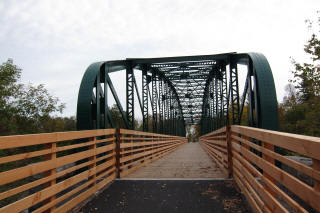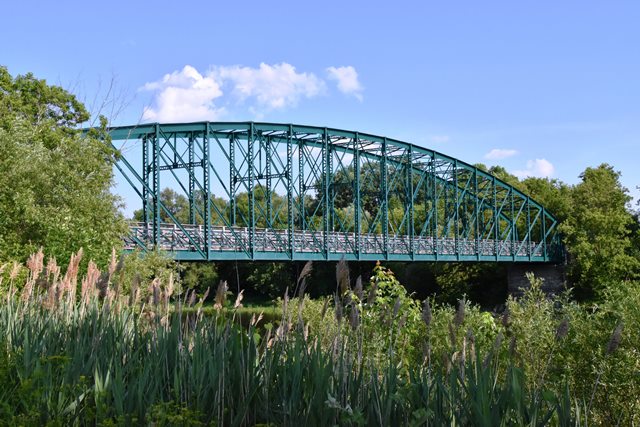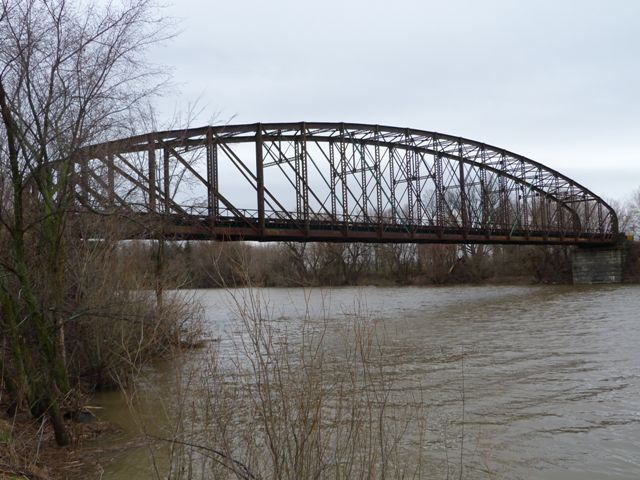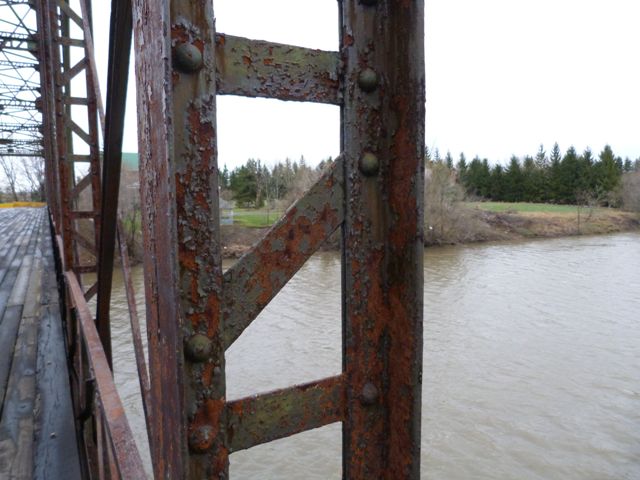We Recommend:
Bach Steel - Experts at historic truss bridge restoration.
BridgeHunter.com Phase 1 is released to the public! - Visit Now
Pont Turcot
Turcot Bridge
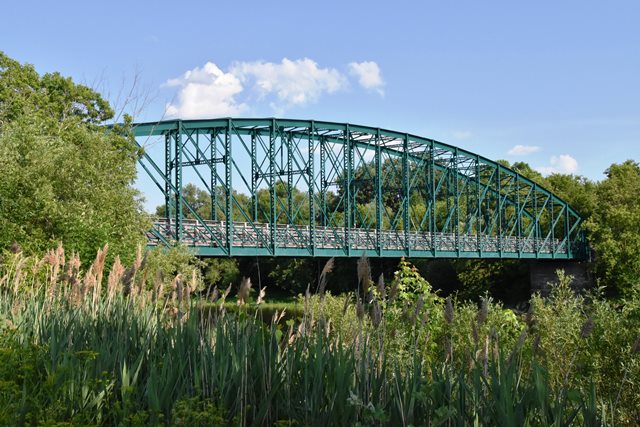
Primary Photographer(s): Nathan Holth and Rick McOmber
Bridge Documented: April 13, 2011 and July 4, 2019
Howick: Montérégie, Québec: Canada
1889 By Builder/Contractor: International Engineering and Construction Company Limited of Braine-le-Comte, Belgium and Engineer/Design: Gérard Macquet
Not Available or Not Applicable
251.3 Feet (76.6 Meters)
263.5 Feet (80.3 Meters)
16.3 Feet (4.97 Meters)
1 Main Span(s)
Not Applicable

View Information About HSR Ratings
Bridge Documentation
Introduction: About Gérard Macquet
In 1887 the Québec government created a program to promote the construction of metal bridges, with the hope of providing better and more durable bridges than the short-lived wooden structures that were being built at the time. The Department of Public Works hired a young Belgian engineer by the name of Gérard Macquet to be the Director of Bridge Construction. Macquet brought with him a European philosophy of bridge construction. Gérard Macquet was the designer of Pont Turcot.
In 1887, wrought iron and pinned connections in metal truss bridges were the most common form of metal bridge throughout North America, for reasons of materials cost, as well as the available types of labor and field equipment available. Steel was being used in railroad rails, and so wrought iron was cheaper. Pinned connections were easy for unskilled labor to assemble in the field and eliminated the need for field riveting, which was difficult prior to the development of the handheld pneumatic rivet hammer. Bridge technology development in this period was focused on economy of materials, ease of assembly, and bridge durability. Many bridge builders attempted to develop unique patented construction details and truss configurations in an attempt to build the best bridge. Later, builders found it easiest to stick with standardized materials and construction details. However it was not until the early 1900s that the extremely important transition to steel and riveted connections in trusses was completed.
Using steel and providing riveted connections in truss bridges was not as problematic in Europe, and so in terms of this aspect of technological development, Europe was for many years significantly ahead of North America in terms of bridge construction. There were also a number of design and cosmetic differences that meant that bridges built in Europe often had different truss configurations and built-up beam styles on them compared to North American bridges. Coming from Europe, Macquet brought with him an understanding of the values of steel, and the feasibility of their construction. Macquet advocated for the use of mild steel and riveted connections in truss bridges. As a result, in his position as Director of Bridge Construction, Québec saw steel bridges being constructed on its roads earlier than other places in North America. Macquet's bridges were also noted for their European styling in terms of design.
A Unique Bridge For North America
Since this bridge was designed by a Belgian engineer, it is perhaps unsurprising that this bridge was fabricated in Belgium by a company whose name appears to translate into "International Engineering and Construction Company Limited." The name seems appropriate, since this overseas contract certainly was a international project. The bridge was shipped to Québec and construction and assembly was undertaken by A. Charlebois and William Doran. Between Macquet's European philosophy into bridge design and the European fabricator, this bridge appears to be the most European bridge in all of North America. The overall truss design which researchers call the "Macquet Parabolic" is very similar to bridges sometimes called "bowstring" bridges in Europe. The design includes a curved top chord as well as a curved end post that ends in a vertical orientation at the bearings. The diagonal members follow a double intersection Pratt. The use of the double-intersection Pratt with a curved top chord and also the use of a curved-to-vertical end post are both design features that are somewhat common in European bridge design. Both are nearly unheard of in North America. Pont Turcot also displays a design in its built-up beams that is either rare or unique in North America, but appears to be strongly based off of common European practice, which gives the beams the appearance of plate rather than box beams. For example, the top chord is composed of paired angles with plate in between. The diagonal members are two angles that are positioned right beside each other and riveted to plate. The vertical members have a design that essentially combines the concept of v-lacing with that of battens: every other bar that runs between the two pairs of angles is an alternating diagonal bar, while in between those are horizontal batten bars. The horizontal sway bracing beams are similar to the vertical members however the diagonal bars do not alternate. Instead, they follow a Pratt truss configuration relative to the length of the beam, a most unusual detail.
Both the overall design of this bridge as well as the composition of its individual beams are strongly European in style. Designed by a European engineer and fabricated in Belgium, this bridge appears to be the most European bridge in North America. Nearly every aspect of this bridge's history, design, and appearance is unique in North America. In addition, the bridge is significant for its impressive span length. On top of that, the bridge has excellent historic integrity with very few alterations. The only noteworthy alteration is the replacement of a couple diagonal members. The historic and technological significance of this bridge cannot be understated. The bridge is one of the most important heritage bridges in North America.
HistoricBridges.org Preservation Recommendations - April 2011
The bridge has been left standing closed to vehicular traffic but accessible to pedestrians. The bridge appears to remain in good physical condition. Although the bridge has very little paint left on it and has rusted, there was no major section loss or pack rust noted on the bridge. Because the bridge is steel and not rust-resistant wrought iron, a good preservation project would be to blast clean and repaint the bridge, and maintain it for pedestrian use only. It does not appear that any major work is needed to the steel itself, but should repairs ever be needed, they should be undertaken using the methods of in-kind restoration. Failed rivets should be replaced with rivets and not modern bolts. The original railings should not be removed. Failed built-up beams should be replaced with exact replicas of the riveted beams, which is especially important with this bridge because the design of its built-up beams is one of its main areas of significance. Another preservation recommendation would be to install interpretive signage for the bridge.
Comments Following Bridge Rehabilitation - January 2012
Above: Photos showing the bridge after repainting, new deck, and new railing added. Photo Credit: Cycle Fun Montreal
In January 2012, HistoricBridges.org was pleased to learn that this rare bridge was restored for non-motorized use. A new wooden deck was installed. The truss was repainted, and the dark green color selected maintains the bridges familiar, dark appearance while not making it so dark that it is hard to photograph and bring out the details of the truss. No major alterations to the truss appear to be visible, which is good. The original railings were retained, something HistoricBridges.org also feels was very important. The only criticism of the project would be that the tall railings composed of numerous wooden boards severely block the view of the historical railings and the historical truss. HistoricBridges.org would have recommended the use of a wooden railing that did not block the view as much. Even better would have been to use a metal railing. Metal railing can be designed in many different ways to meet safety requirements for a pedestrian bridge, while also avoiding the visual obstruction commonly found with wooden railing. The railing is a minor issue however since the most important fact is that the bridge itself has not been altered and has been protected by a coat of paint. The added railing could be changed to something different at a later date.
Additional Resources
Below are a number of links to documents and websites that may be of interest. Because this page serves to document one of the most important heritage bridges in Québec and because it also was among the first bridges from Québec on HistoricBridges.org this page was found to be an appropriate place to list some links also dealing with the evaluation of heritage bridges in general in Québec. Unlike most of the provinces in Canada, Québec appears to have a much more organized and developed inventory and management plan for its heritage bridges. A number of the links below provide evidence of this.
Official Transports Québec Heritage Bridges Website - Provides an overview of heritage bridges in Québec.
Gérard Macquet Biography - A detailed paper that explores Gérard Macquet's life and accomplishments with bridge construction in Québec.
Additional Gérard Macquet Information - An article that discusses Gérard Macquet.
Overview of Asset Management of Heritage Bridges in Québec - An overview presentation that discusses the management of heritage bridges in Québec.
Heritage Bridges Québec Evaluation Manual - Potential heritage bridges in Québec are evaluated using a points based scoring system. The scoring system not only provides guidance as to the heritage significance of a potential bridge, it also suggests whether the bridge should be prioritized for rehabilitation or restoration. This manual serves to detail the scoring system and other information relating to the evaluation of heritage bridges.
Heritage Bridge Identification and Management Guide - This guide covers similar topics as the above manual but is more geared toward the general public seeking basic information about the management system rather than someone wishing to learn exactly how the bridges are evaluated.
1892 Report By Gérard Macquet On Metal Bridges In Québec (View An English Translation) - A primary source document that was part of a report contained in the sessional papers for the Québec legislature.
De l'information Répertoire du patrimoine culturel du QuébecOriginal Text In French Description Le pont Turcot, classé monument historique, est un
ouvrage de génie civil construit en 1889. Ce pont d'une travée mesure
76,6 mètres de long et 4,98 mètres de large. La structure rivetée en
acier est composée de fermes paraboliques à treillis à double
intersection. Elle repose sur des culées en pierre de taille. Situé en
milieu rural, à proximité du noyau villageois, le pont Turcot permet
d'enjamber la rivière Châteauguay, dans la municipalité de Très-Saint-Sacrement. Valeur patrimoniale La valeur patrimoniale du pont Turcot repose sur son
intérêt historique. Il s'agit de l'un des premiers ponts bâtis dans le
cadre de la Politique des ponts métalliques, instaurée par le
gouvernement d'Honoré Mercier (1840-1894) en 1887. Dans la deuxième
moitié du XIXe siècle, les municipalités sont chargées de la
construction des ponts sur leur territoire. Généralement en bois et non
couverts, ces ponts ont une durée de vie d'une dizaine d'années et sont
fréquemment détruits par des embâcles ou des crues. Leur fragilité
affecte ainsi le réseau de transport et nuit au développement de
l'agriculture. La Politique des ponts métalliques est adoptée pour
favoriser la construction de ponts en métal, plus résistants. Les
municipalités assument le coût des culées en maçonnerie, des chemins
d'approche et l'équivalent du coût de construction d'un pont en bois,
tandis que le gouvernement accorde une subvention couvrant les sommes
supplémentaires nécessaires pour faire ériger une structure métallique.
Une cinquantaine de ponts ont été construits avant l'abolition de cette
politique en 1892. Le pont Turcot, élevé en 1889 pour franchir la
rivière Châteauguay en remplacement d'un pont saisonnier sur chevalets,
est le deuxième de cette série. Il rappelle les efforts déployés à la
fin du XIXe siècle afin de consolider le réseau routier et d'améliorer
la circulation des produits agricoles. Éléments caractéristiques Les éléments caractéristiques du pont Turcot liés à
son intérêt historique comprennent, notamment : Information historique Année : 1889 (Construction) Charlebois, A. Constructeur Gérard Macquet Profession : Ingénieur Gérard Macquet est né à Bruges, en Belgique, le 5
décembre 1859. Synthèse historique Le pont Turcot est bâti dans le cadre de la
Politique des ponts métalliques, instaurée par le gouvernement d'Honoré
Mercier (1840-1894) en 1887. La politique encourage la construction de
ces ponts, moins vulnérables que ceux en bois, afin d'améliorer le
réseau routier et de faciliter le transport des produits agricoles. Les
municipalités assument le coût des culées en maçonnerie, de
l'aménagement des chemins d'approche et l'équivalent du coût de
construction d'un pont en bois, tandis que le gouvernement accorde une
subvention couvrant les sommes supplémentaires nécessaires pour faire
ériger une structure métallique. Notices bibliographiques DANDOIS, Marie-Christine et Jean LEFRANÇOIS. Les
ponts Macquet au Québec : Un héritage à conserver. s.l. 4e Conférence
spécialisée en génie des structures de la Société canadienne de génie
civil, 2002. 10 p. |
Information From Directory of Québec's cultural heritageEnglish Translation DescriptionTurcot Bridge, a historical monument, is a civil engineering structure built in 1889. The bridge of a span measure 76.6 meters long and 4.98 meters wide. The riveted steel structure is composed of farms double parabolic truss intersection. It rests on stone abutments. Located in rural, near the village core, the bridge can span the Turcot Châteauguay River in the municipality of the Most Blessed Sacrament. Usage: Transport, communications and utilities (Bridges and structures) Heritage The heritage value of Turcot Bridge based on its historical significance. It is one of the first bridges built as part of the Policy of steel bridges, introduced by the government of Honoré Mercier (1840-1894) in 1887. In the second half of the nineteenth century, municipalities are responsible for the construction of bridges on their territory. Usually made of wood and not covered, these bridges have a lifespan of ten years and are frequently destroyed by floods or ice jams. Their fragility and affects the transportation system and affects the development of agriculture. The Politics of steel bridges was adopted to encourage the construction of metal bridges, stronger. Municipalities bear the cost of the stone abutments, approach roads and the equivalent cost of building a wooden bridge, while the government provides a subsidy to cover the additional funds necessary to erect a steel structure. Fifty bridges were built before the abolition of this policy in 1892. Turcot Bridge, erected in 1889 to cross the Châteauguay River in lieu of a seasonal bridge trestle, is the second of this series. He recalled the efforts made in the late nineteenth century to build roads and improve the circulation of agricultural products. The heritage value of the bridge Turcot also relies on its association with Gérard Macquet (b. 1859). To promote the integration of French as the language used in engineering projects, the Government urges that Mercier Body Belgian engineer of Roads and Bridges. This was immediately appointed director of the construction of steel bridges. It quickly breaks with common practice in North America, which was only specify the width and scope necessary, leaving the contractors to decide the type of bridge. Macquet and his team prepare plans and specifications and spread very detailed and entrepreneurs in the design of structures. Until his departure in 1892, the engineer overseeing the development of thirty bridges built as part of the Policy and bridges. Few of them remain. Turcot Bridge is therefore an exceptional witness of his work in Quebec. The heritage value of the bridge Turcot is also based on its technological interest. The book reflects the introduction into Québec of mild steel structures completely riveted. In the last decades of the nineteenth century, North America, several steel bridges were erected, including the rail network. Cast iron is often used, and structures are usually assembled articulated wire pins. This type is rejected by Macquet, who prefers mild steel bridges completely riveted, more prevalent in Europe. Although they are more expensive, the engineer insisted on their stability, rigidity and durability larger and their maintenance easier, reducing costs in the long term. It also introduces two new structures, or the beam and the beam Schwedler dish called "Macquet. Turcot Bridge belongs to the second model in its upper strings and parabolic mesh double intersection. It is a perfect example of the Quebec Civil Engineering of the second half of the nineteenth century and the use of a European-inspired technology. Source: Ministère de la Culture, des Communications et de la Condition féminine du Québec, 2009. Characteristic features The characteristic features of Turcot Bridge linked to its historical interest include the following: - The situation in rural areas, near the village center, on the Châteauguay River. The characteristic features of the bridge Turcot related to its technological interest include the following: - Span measuring 76.6 meters long and 4.98 meters wide; - Materials including mild steel parts as well as the stone abutments; - Characteristics of the structural beam parabolic Macquet, whose assembly, rivet, the upper strings dishes, the lower strings straight, the uprights connecting the upper strings at abutments and lower strings, the diagonal parts of the extremities, the lattice double intersection, the pieces of bracing and rolls of expansion. Historical Information Year: 1889 (Construction) Character group and event: Charlebois, A. Manufacturer Doran, William Builder Macquet, Gerard Architect / Designer Anonymous Society International Building and Construction Companies Manufacturer Gérard Macquet Occupation: EngineerGérard Macquet was born in Bruges, Belgium, December 5, 1859. Macquet entered the preparatory school in 1877 and then studied at the special school of civil engineering, from which he graduated in 1881. Immediately after graduation, he joined the Belgian Corps des Ponts et Chaussées. In 1887, the government of Honoré Mercier creates policy for metal bridges. This policy encourages the construction of these bridges, less vulnerable than wood, to improve the road network in the province of Quebec and facilitate transportation of agricultural products. The Department of Public Works then recruits the young Belgian engineer Gérard Macquet, who was immediately appointed director of bridge construction. It is also committed to promote the use of French in engineering projects. Once in office, Macquet advocates building bridges completely riveted mild steel, such as those prevalent in Europe. It introduces two new types of structures in the Quebec landscape, or the beam and the beam parabolic Schwedler Macquet. These structures are economical and easy to erect. He broke with accepted practice in North America, leaving entrepreneurs to decide the type of bridge. The engineer and his team prepare plans and specifications and spread very detailed and entrepreneurs in the design of structures. In 1892, facing an economic crisis, the State terminates the program and Macquet is released from his duties. From 1887 to 1892, thirty steel bridges designed by Macquet were built in Quebec. It is now six of these structures, including bridges beam parabolic Macquet of the Most Blessed Sacrament (1889), Saint-Gabriel-de-Valcartier (1892) and Hébertville (1892), the girder Schwedler Saint-Raymond (1889) and St. Thomas (1892), and the Pratt truss bridge of Saint-Eugène (1891). During his time in the province of Quebec, Macquet has also served on the first board of directors of the Belgian Society of beneficence and protection for immigrants, founded in Quebec in 1890. Historical Synthesis Turcot Bridge was built as part of the Policy of steel bridges, introduced by the government of Honoré Mercier (1840-1894) in 1887. The policy encourages the construction of these bridges, less vulnerable than wood, to improve the road network and facilitate transportation of agricultural products. Municipalities bear the cost of the stone abutments, development paths of approach and the equivalent cost of building a wooden bridge, while the government provides a subsidy to cover the additional funds necessary to erect a metal structure. To promote the integration of French as the language used in engineering projects, the government commits Macquet Gerard (born 1859), an engineer of the Corps des Ponts et Chaussées Belgian. It was named director of the construction of steel bridges. Macquet breaks with current practice in North America, which allows entrepreneurs to decide the type of bridge. The engineer and his team prepare plans and specifications and spread very detailed and entrepreneurs in the design of structures. It also calls for mild steel bridges completely riveted prevalent in Europe as well as introducing two new structures, or the beam and the beam Schwedler dish called "Macquet. Until his departure in 1892, Macquet oversee the development of thirty bridges built as part of the Policy and bridges. Turcot Bridge, designed by Macquet, is the second high bridge after the adoption of the Policy. The structure replaces a seasonal bridge toll on easels, operated for over forty years by the family Turcot, who owns the land along the rivers. The new bridge allows farmers greater access to market Beauharnois. In March 1888, a draft is submitted. The costs incurred by the municipality are accepted by it in June. Plans and specifications for masonry abutments developed by the government are received soon after. Meanwhile, bids for the manufacture of the metal structure is required. Société Anonyme International Construction and engineering company in Braine-le-Comte, Belgium, lowest bidder gets the contract. This company has completed several other steel bridges in Quebec at that time. At the request of the municipality, the work is carried forward in the spring of 1889. The installation requires the addition of the abutments of a pile foundation. William Doran, in charge of the work, does not respect the time and only several formal manage to make him finish the book in September. Farmers around ADJUST avenues of approach, made of stone and clay. The metal parts are manufactured in Belgium sent in Howick by boat and train. The assembly of the structure, performed by the Contractor A. Charlebois, began in September 1889 and ends December 24. The total cost amounts to $ 23 285. After his inspection in March 1890, the bridge is opened to traffic. Few elements of the bridge were changed. The deck has been solidified, including by replacing the longitudinal beams of other wooden and steel sleepers covered the addition of creosote. The framework remains intact, with the exception of six pieces of mesh that were replaced by other rolled steel fixed with bolts. From the mid-twentieth century, metal bridges are gradually giving way to concrete structures, but the bridge is kept Turcot. It is closed to traffic in 2000. Friends of Turcot Bridge take the initiative to ask for the classification prevent it from being demolished. Turcot Bridge is a historical monument in 2009. It is a historic monument in the same year. Bibliographic records DANDOIS, Marie-Christine and Jean LEFRANÇOIS. Macquet bridges in Quebec: A legacy to preserve. sl 4th Conference specializing in structural engineering from the Canadian Society for Civil Engineering, 2002. 10 p. LEFRANÇOIS, John. "Gérard Macquet, a visionary engineer." Continuity. Vol. 95 (2003), p. 22-23. Passfield, Robert W. "The Politics of steel bridges." Aqpi newsletter. Vol. 5, No. 3 (1993), p. 1-3. Passfield, Robert W. "The Turcot Riveted Arch-Truss Bridge". The Journal of the Society for Industrial Archeology. Vol. 23, No. 2 (1997), p. 21-47. the Upper St. Lawrence: nature and culture. Quebec, Continuity, s.d. 8 p. |
![]()
Photo Galleries and Videos: Pont Turcot
2019 Bridge Photo-Documentation
Original / Full Size PhotosA collection of overview and detail photos. This gallery offers photos in the highest available resolution and file size in a touch-friendly popup viewer.
Alternatively, Browse Without Using Viewer
![]()
2019 Bridge Photo-Documentation
Mobile Optimized PhotosA collection of overview and detail photos. This gallery features data-friendly, fast-loading photos in a touch-friendly popup viewer.
Alternatively, Browse Without Using Viewer
![]()
2011 Structure Overview
Original / Full Size PhotosA collection of overview photos that show the bridge as a whole and general areas of the bridge. This gallery offers photos in the highest available resolution and file size in a touch-friendly popup viewer.
Alternatively, Browse Without Using Viewer
![]()
2011 Structure Details
Original / Full Size PhotosA collection of detail photos that document the parts, construction, and condition of the bridge. This gallery offers photos in the highest available resolution and file size in a touch-friendly popup viewer.
Alternatively, Browse Without Using Viewer
![]()
2011 Structure Overview
Mobile Optimized PhotosA collection of overview photos that show the bridge as a whole and general areas of the bridge. This gallery features data-friendly, fast-loading photos in a touch-friendly popup viewer.
Alternatively, Browse Without Using Viewer
![]()
2011 Structure Details
Mobile Optimized PhotosA collection of detail photos that document the parts, construction, and condition of the bridge. This gallery features data-friendly, fast-loading photos in a touch-friendly popup viewer.
Alternatively, Browse Without Using Viewer
![]()
Overview of historic bridges in Québec.
Full Motion VideoFrench Language. Video Source: Transports Québec Streaming video of the bridge. Also includes a higher quality downloadable video for greater clarity or offline viewing.
![]()
Rehabilitation of pont MacKenzie.
Full Motion VideoFrench Language. Video Source: Transports Québec. This video provides evidence that historic bridges can have a bright future in Québec Streaming video of the bridge. Also includes a higher quality downloadable video for greater clarity or offline viewing.
![]()
Maps and Links: Pont Turcot
Coordinates (Latitude, Longitude):
Search For Additional Bridge Listings:
Additional Maps:
Google Streetview (If Available)
GeoHack (Additional Links and Coordinates)
Apple Maps (Via DuckDuckGo Search)
Apple Maps (Apple devices only)
Android: Open Location In Your Map or GPS App
Flickr Gallery (Find Nearby Photos)
Wikimedia Commons (Find Nearby Photos)
Directions Via Sygic For Android
Directions Via Sygic For iOS and Android Dolphin Browser


